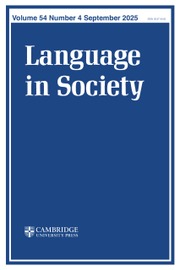Crossref Citations
This article has been cited by the following publications. This list is generated based on data provided by
Crossref.
Gerhardt, Julie
1988.
From discourse to semantics: the development of verb morphology and forms of self-reference in the speech of a two-year-old.
Journal of Child Language,
Vol. 15,
Issue. 2,
p.
337.
Nelson, Katherine
1989.
Memory: Interdisciplinary Approaches.
p.
127.
Budwig, Nancy
1989.
The linguistic marking of agentivity and control in child language.
Journal of Child Language,
Vol. 16,
Issue. 2,
p.
263.
Gerhardt, Julie
1991.
The meaning and use of the modals HAFTA, NEEDTA and WANNA in children's speech.
Journal of Pragmatics,
Vol. 16,
Issue. 6,
p.
531.
Gerhardt, Julie
and
Stinson, Charles
1994.
The Nature of Therapeutic Discourse: Accounts of the Self.
Journal of Narrative and Life History,
Vol. 4,
Issue. 3,
p.
151.
Gerhardt, Julie
and
Stinson, Charles
1995.
“I don't know”;: Resistance or groping for words? The construction of analytic subjectivity.
Psychoanalytic Dialogues,
Vol. 5,
Issue. 4,
p.
619.
Gallup, Gordon G.
1996.
Rhesus monkeys are radical behaviorists.
Behavioral and Brain Sciences,
Vol. 19,
Issue. 1,
p.
129.
Barresi, John
and
Moore, Chris
1996.
Understanding self and other.
Behavioral and Brain Sciences,
Vol. 19,
Issue. 1,
p.
142.
Budwig, Nancy
and
Bamberg, Michael
1996.
Language and its role in understanding intentional relations: Research tool or mechanism of development?.
Behavioral and Brain Sciences,
Vol. 19,
Issue. 1,
p.
125.
Dwyer, Susan
1996.
Moral competence is cognitive but (perhaps) nonmodular.
Behavioral and Brain Sciences,
Vol. 19,
Issue. 1,
p.
128.
Ze'ev, Aaron Ben
and
Oatley, Keith
1996.
Development of social emotions and constructive agents.
Behavioral and Brain Sciences,
Vol. 19,
Issue. 1,
p.
124.
Nelson, Katherine
1996.
Four-year-old humans are different: Why?.
Behavioral and Brain Sciences,
Vol. 19,
Issue. 1,
p.
134.
Barresi, John
and
Moore, Chris
1996.
Intentional relations and social understanding.
Behavioral and Brain Sciences,
Vol. 19,
Issue. 1,
p.
107.
Hobson, R. Peter
1996.
Understanding minds and selves.
Behavioral and Brain Sciences,
Vol. 19,
Issue. 1,
p.
132.
Olson, David R.
and
Homer, Bruce
1996.
Understanding that looking causes knowing.
Behavioral and Brain Sciences,
Vol. 19,
Issue. 1,
p.
135.
1996.
The Handbook of Child Language.
p.
691.
Morton, Adam
1996.
But what is the intentional schema?.
Behavioral and Brain Sciences,
Vol. 19,
Issue. 1,
p.
133.
Baron-Cohen, Simon
1996.
Can children with autism integrate first and third person representations?.
Behavioral and Brain Sciences,
Vol. 19,
Issue. 1,
p.
123.
Oosterwegel, Annerieke
1996.
Social relations and understanding the intentional self.
Behavioral and Brain Sciences,
Vol. 19,
Issue. 1,
p.
136.
Premack, David
and
Premack, Ann James
1996.
Intentional schema will not do the work of a theory of mind.
Behavioral and Brain Sciences,
Vol. 19,
Issue. 1,
p.
138.

